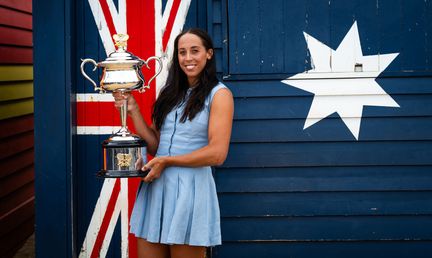NEW YORK, NY, USA – In a quiet corner of the US Open media center, I march over to meet with the World No.1.
GALLERY: Doubles Delight - Barbora Strycova's Journey to Wolrd No.1
Not even defending champion Naomi Osaka’s gaggle of Japanese journalists – much less the international media attention she attracts - would fit within the cubicle confines of Interview Room Six. It is, instead, a perfect place to catch up with Barbora Strycova, who won Wimbledon (alongside partner Hsieh Su-Wei) to sit atop the WTA Doubles rankings.
Typically flanked by her own cadre of Czech press, Strycova went unrequested on a Saturday afternoon that saw she and Hsieh win an eighth straight Grand Slam match and become the first team to qualify for the Shiseido WTA Finals Shenzhen.
It has been one of the few relaxed days the 33-year-old, who has gone from the tennis court to the cover of Elle Czech, has enjoyed since achieving all she ever dreamed of doing in under a week at the All England Club.
“To be honest,” she says, placing her phone on the table, “I haven’t really had any time, just two days with my boyfriend, where we were just out of Prague, and didn’t travel anywhere.
“So many things happened. The first week was very busy, but I’ve wanted to relax and be alone with myself, to process what happened. You almost don’t realize it when it’s happening because you’re focused on different things. I did something very special, for me, the highlight of my career and life.”
Strycova not only lifted her first major trophy in doubles, but also broke new ground at her favorite tournament in singles, upsetting British No.1 Johanna Konta to reach her first Grand Slam semifinal. With only a month since the Champions Ball, she nonetheless appears unbothered in Flushing Meadows, white jacket zipped, striped collar popped.
“I was feeling so great during these two weeks that I really didn’t have any doubt, and then I had to figure out how to be happy while knowing I have to go out and practice again. This was really tough, I have to say. It was tough on my body, on my mentality. It was tough to come back and work again, but I had new motivation.”
Like Osaka, Strycova has expected these results of herself since her days as a top prospect at her childhood academy in Plzen, and later as she turned pro after winning the 2002 Australian Open girl’s singles title. Unlike Osaka, her tale of triumph and disaster took longer to tell.
“I’ve been waiting for this success nearly 25 years. I was successful as a junior, and everyone felt I had to be successful on the WTA because I was No.1 in juniors. It was already a pressure on me. Suddenly, it has come, and to be honest with you, I dreamed about this all my life, but I was also doubting if I could do it because I’m 33 right now, thinking that I might never achieve what I could.”
Peaking just outside the Top 15 two years ago in singles, the Olympic bronze medalist has tended to excel in doubles with the help of her expert anticipation and all-court game, but never with a consistent partner until 2018, when she and former academy rival Andrea Sestini Hlavackova qualified for the WTA Finals in Singapore.
For Strycova, it was a baseline milestone, one she wouldn’t have accepted retiring without. It allowed her to set bigger goals for the season to come, and ultimately become what she always thought she would be.
“I questioned myself before the grass season. I thought, ‘Ok, even if you don’t achieve it, let’s just try to put everything you have on a surface you love. If it doesn’t happen, you still gave it your all.’ Suddenly, I did it, and I was so free: of thoughts, doubts.
“I was not afraid to be scared.”
Thoughtful and self-assured, Strycova is fully formed as both athlete and person. She starts her Manhattan mornings at the same coffeehouse and indulges in @barbeefun, an off-shoot of her official Instagram page that centers her passion for fashion.
“I love to talk about it.” Her blue eyes brighten and her speech – already at a jaunty pace – quickens at the mention of the account. “I love fashion, reading about it, how they make everything, how they create dresses – Dior is my favorite – down to how they stitch things together. It’s not even that I like to shop, but when I do, I like to look at everything, even secondhand and cool stuff like that.
“Bar are the first letters of my name, bee is like my nickname, and fun, so let’s put it together and you have @barbeefun!”
With boyfriend and Elle Czech magazine editor Petr Matejcek – “He is the editor and I was on the cover, but of course, it was because I won Wimbledon!” she laughs – they window shop and scope out restaurants featured on Chef’s Table, their favorite Netflix series.
“He goes with me to the shops, and we talk about fashion. He tells me his opinion and sometimes he knows much more about it, because he can tell me all the stories about Chanel, Dior, and other designers I don’t even know. Then, I can see a t-shirt and know the story behind it, and why it’s so expensive! I still don’t buy it!”
She serves as a particularly stark contrast at a tournament overrun by the precocious teenagers she, herself, once was.
“Someone like Coco Gauff is playing freely right now. She has nothing to defend and nobody is expecting anything from her. Sometimes it can be tough the next year because then you think about how everyone expects you to win, and that can be really difficult. But I feel like someone young, who is getting there and climbing the rankings, even if she doesn’t do it by the time she’s 22, it’s ok. She’ll get experience, and maybe even enjoy it more at 25.”
That she survived and thrived for nearly two decades on tour is a testament, she believes, to a strong character.
“Since I was young, I’ve been a little bossy. and sometimes too much. That’s who I am and how my parents…”
She pauses and smiles, scrunching her face.
“Well, not my parents, it was more me feeling like I needed to be bossy! To be honest, tennis is really difficult to be a part of in the world, especially for women. You have to stand up sometimes for your rights, for the things you want to do. If you are a character that doesn’t like doing that, it can be tougher than if you’re the kind of person who says, ‘I’m here. This is me, and I want to do good.’
“Sometimes it’s hard, and I had ups and downs but I’m 33 years old, and when I was going from juniors to seniors, it was a really hard time. I had good people around me who taught me a lot of good and wise stuff. I’m still learning to stand up sometimes.”
Hsieh perhaps provides the final ingredient to her evolution. Matching Strycova in natural talent, the former WTA Doubles World No.1’s laissez-faire approach counters the Czech’s palpable intensity.
“She was telling me, ‘I had a free day, so I got a manicure because it was raining.’ It’s the middle of a tournament and so you’re looking at her like, ‘Oh really?’ but then you think, ‘Why not?’ I’m not that person, but having her next to me, it makes us equal.”
Together as the No.2 seeds in New York, Hsieh and Strycova stand four wins from a second straight major title. Reaching the pinnacle of the sport, it seems, has only made the World No.1 ready for more.
“To be honest, I don’t want to come down, but you have to. This is tough in tennis, because you’ve achieved something really special, but in two weeks, everyone is like, ‘Ok, but now it’s the US Open.’
“I don’t need to prove anything anymore, but I still feel like I have something in me to do.”
Whatever she does next, she’ll do it in style.







